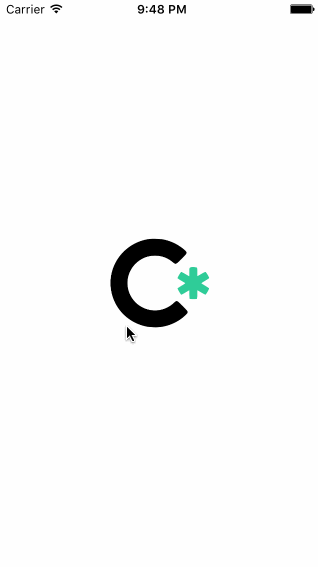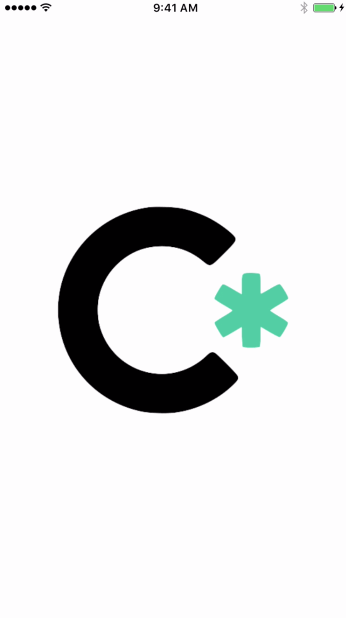Moving and Transforming Views with Gestures - codepath/ios_guides GitHub Wiki
Interactive Gestures can really bring your UI to life! In this guide we will explore some common use-cases for moving and transforming views based on gesture input.
Use Case: Slide Out Tray

Slide out trays, Hamburger menus, and any other view you want to move by sliding your finger can be configured using a UIPanGesture Recognizer.
Step 1: Add a UIView to Serve as Your Tray
- You can add a View in Storyboard or add a view programmatically
- If you added a view in Storyboard, create an outlet for your view. We will name the outlet
trayView.
Step 2: Add and Configure your Pan Gesture Recognizer.
- Attach a UIPanGestureRecognizer to your Tray view and create an Action/Method. We will call our method,
didPanTray. You can add a Gesture Recognizer in Storyboard or add a Gesture Recognizer programmatically
Step 3: Define a Variable to Hold the Initial Position of the View
Define an Instance Variable that can be accessed throughout the View Controller. We define these variables at the top of the ViewController Swift file, right above the viewDidLoad method.
var trayOriginalCenter: CGPoint!
Step 4: Make the Tray Draggable

The code to make the Tray draggable will go inside our didPanTray method.
NOTE: If you created your Gesture Recognizer and added an Action in Storyboard, the method will be proceeded by @IBAction.
@IBAction func didPanTray(sender: UIPanGestureRecognizer) {
}
- Within the
didPanTraymethod, we want to access the translation property of the UIPanGestureRecognizer and store it in a variable. This will tell us how far our finger has moved from the original "touch-down" point as we drag. We will also print the translation value to the console to get a feel for what it means. You should see that the translation is a CGPoint with values for the x and y components.
var translation = sender.translationInView(view)
print("translation \(translation)")
- Create a conditional statement to check for the current gesture state during the pan: .Began, .Changed or .Ended
.Beganis called once at the very beginning of each gesture recognition..Changedis called continuously as the user is in the process of "gesturing"..Endedis called once at the end of the gesture.- HINT: You will use this conditional statement to check gesture states SO often, that is extremely helpful to create a Code Snippet for quick access in the future!
if sender.state == UIGestureRecognizerState.Began {
} else if sender.state == UIGestureRecognizerState.Changed {
} else if sender.state == UIGestureRecognizerState.Ended {
}
- When the gesture begans (
.Began), store the tray's center into the trayOriginalCenter variable:
trayOriginalCenter = trayView.center
- As the user pans (
.Changed), change thetrayView.centerby the translation. Note: we ignore the x translation because we only want the tray to move up and down:
trayView.center = CGPoint(x: trayOriginalCenter.x, y: trayOriginalCenter.y + translation.y)
5: Animate Tray to Open or Closed Positions

When a user stops panning the Tray, we want the tray to animate to an up or down position. We will infer that if the users last gesture movement was downward, they intend to close the tray to it's down position. Conversely, if they are NOT panning down, they must be panning up, and intend to open the tray to it's up position.
We can tell which way a user is panning by looking at the gesture property, velocity. Like translation, velocity has a value for both x and y components. If the y component of the velocity is a positive value, the user is panning down. If the y component is negative, the user is panning up.
Since we are focusing on the user's last gesture movement, we will check for the velocity in the .Ended condition of our gesture state conditional statement.
- Get the velocity:
var velocity = sender.velocityInView(view). Pan Gesture Recognizer - Define Instance variables to store the tray's position when it's "up" and "down" as well as the offset amount that the tray will move down when it is in it's down position.
var trayDownOffset: CGFloat!
var trayUp: CGPoint!
var trayDown: CGPoint!
- Within the
viewDidLoadmethod, assign values to thetrayDownOffset,trayUpandtrayDownvariables . ThetrayDownOffsetwill dictate how much the tray moves down. 160 worked for my tray, but you will have to adjust this value to accommodate the specific size of your tray.
trayDownOffset = 160
trayUp = trayView.center
trayDown = CGPoint(x: trayView.center.x ,y: trayView.center.y + trayDownOffset)
- Back in your
didPanTraymethod, within the gesture state,.Ended, create a conditional statement to check the y component of the velocity. In the case that the tray is moving down, animate the tray position to thetrayDownpoint, otherwise, animate it towards thetrayUppoint. Animating View Properties
if velocity.y > 0 {
UIView.animateWithDuration(0.3, animations: { () -> Void in
trayView.center = trayDown
})
} else {
UIView.animateWithDuration(0.3, animations: { () -> Void in
trayView.center = trayUp
})
}
You can also try animating the ending tray motion with a bounce using the damping ratio and initial spring velocity. Spring Animation
Use Case: Scaling and Rotating a View
This Use-Case will explore using multiple gesture recognizers simultaneously to scale and rotate an ImageView.

Step 1: Add an ImageView
- You can add an ImageView from The Media Library to the Storyboard or add a view programmatically
- Make sure that the Image View has user interaction enabled.
Step 2: Add and Configure the Gesture Recognizers
- Attach a UIPinchGestureRecognizer and a UIRotationGestureRecognizer to your Image View and create an Action/Method for each one. We will call our methods,
didPinchanddidRotate. You can add a Gesture Recognizer in Storyboard or add a Gesture Recognizer programmatically
Step 3: Allow for Simultaneous Gesture Recognizers
Since we will be using multiple gesture recognizers at the same time, we will need to configure our ViewController to support Simultaneous Gesture Recognizers.
Step 4: Make the Image View Scalable

Within the didPinch method...
- Access the scale parameter of the Pinch Gesture Recognizer and store it in a constant.
- Access the view that was pinched and store it in a constant.
sender.viewreturns a generic UIView so we need to specify that we are working with a UIImageView usingas! UIImageView.
- Store the previous transform state of the imageView in a constant.
- Modify the scale component of the imageView's transform property.
- NOTE: We use
CGAffineTransformScaleinstead ofCGAffineTransformMakeScale. This is becauseCGAffineTransformScaleallows us to add to the previous transform state as an argument,previousTransfromwhereasCGAffineTransformMakeScalewill overwrite it completely. Combining Transforms
- NOTE: We use
- Set the scale of the UIPinchGestureRecognizer back to 1.
- Resetting the scale is necessary because we are adding the scale to the
previousTransformeach time the method is called. If we didn't reset the scale, each time around the scale that was added to thepreviousTransformwould be doubled and our Image View would scale out of control! But don't take my word for it, run the app without resetting the scale back to 1 and see what happens!
- Resetting the scale is necessary because we are adding the scale to the
@IBAction func didPinch(sender: UIPinchGestureRecognizer) {
let scale = sender.scale
let imageView = sender.view as! UIImageView
let currentTransform = imageView.transform
imageView.transform = CGAffineTransformScale(imageView.transform, scale, scale)
sender.scale = 1
}
Step 5: Make the Image View Rotatable

Within the didRotate method...
- Access the rotation parameter of the Rotation Gesture Recognizer and store it in a constant.
- Access the view that was rotated and store it in a constant.
sender.viewreturns a generic UIView so we need to specify that we are working with a UIImageView usingas! UIImageView.
- Store the current transform state of the imageView
- Modify the rotation component of the imageView's transform property.
- NOTE: We use
CGAffineTransformRotateinstead ofCGAffineTransformMakeRotatefor the same reasons we chose our scale transform method. Combining Transforms
- NOTE: We use
- Set the rotation of the UIRotationGestureRecognizer back to 0.
@IBAction func didRotate(sender: UIRotationGestureRecognizer) {
let rotation = sender.rotation
let imageView = sender.view as! UIImageView
let previousTransform = imageView.transform
imageView.transform = CGAffineTransformRotate(previousTransform, rotation)
sender.rotation = 0
}